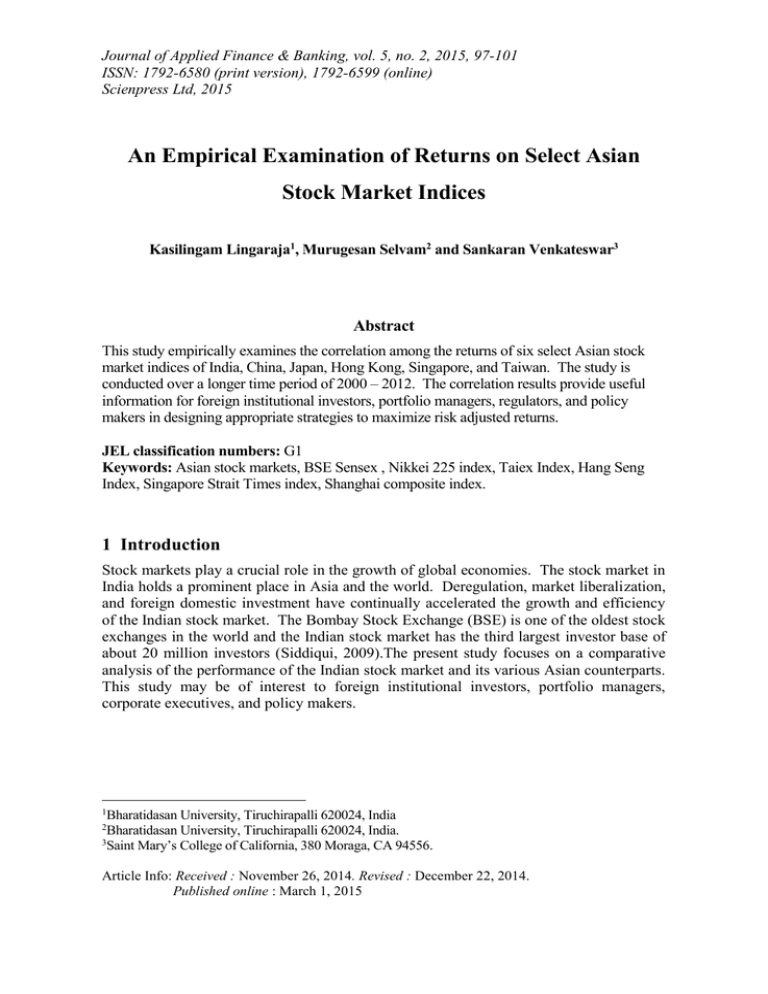Document 13725617
advertisement

Journal of Applied Finance & Banking, vol. 5, no. 2, 2015, 97-101 ISSN: 1792-6580 (print version), 1792-6599 (online) Scienpress Ltd, 2015 An Empirical Examination of Returns on Select Asian Stock Market Indices Kasilingam Lingaraja1, Murugesan Selvam2 and Sankaran Venkateswar3 Abstract This study empirically examines the correlation among the returns of six select Asian stock market indices of India, China, Japan, Hong Kong, Singapore, and Taiwan. The study is conducted over a longer time period of 2000 – 2012. The correlation results provide useful information for foreign institutional investors, portfolio managers, regulators, and policy makers in designing appropriate strategies to maximize risk adjusted returns. JEL classification numbers: G1 Keywords: Asian stock markets, BSE Sensex , Nikkei 225 index, Taiex Index, Hang Seng Index, Singapore Strait Times index, Shanghai composite index. 1 Introduction Stock markets play a crucial role in the growth of global economies. The stock market in India holds a prominent place in Asia and the world. Deregulation, market liberalization, and foreign domestic investment have continually accelerated the growth and efficiency of the Indian stock market. The Bombay Stock Exchange (BSE) is one of the oldest stock exchanges in the world and the Indian stock market has the third largest investor base of about 20 million investors (Siddiqui, 2009).The present study focuses on a comparative analysis of the performance of the Indian stock market and its various Asian counterparts. This study may be of interest to foreign institutional investors, portfolio managers, corporate executives, and policy makers. 1 Bharatidasan University, Tiruchirapalli 620024, India Bharatidasan University, Tiruchirapalli 620024, India. 3 Saint Mary’s College of California, 380 Moraga, CA 94556. 2 Article Info: Received : November 26, 2014. Revised : December 22, 2014. Published online : March 1, 2015 98 Kasilingam Lingarajaet al. 2 Literature Review There have been numerous studies focused on Asian stock markets. Cheung and Mak (1992) found that the US stock markets had an impact on many of the Asian stock markets with the exception of three relatively closed markets in Korea, Taiwan and Thailand. They also found that the Japanese stock market had less influence on other Asian stock markets. Arshanapalli et al. (1995) examined the stock market performance between the US and six major Asian stock markets before and after October 1987 market crash in the US. They concluded that the Asian equity markets were less integrated with Japanese equity market than they were with the US stock market. Selvam et al. (2007) studied evidences of time varying volatility which exhibited clustering, high persistence and predictability for almost all the ten Asian market indices in their sample. The present study aims to add to the literature by using a more robust sample over a longer time period than prior studies that focused on the performance of Asian stock markets. 3 Research Methodology The present study covers a longer time period from 01/07/2000 to 30/06/2012. To better understand time varying results, the time period was divided into three equal parts. The first period is from 01/07/2000 to 30/06/2004, the second period from 01/07/2004 to 30/06/2008, and the third period from 01/07/2008 to 30/06/2012. The following stock indices were selected for study from six Asian stock markets. The BSE Sensex index from India, the Hang Seng index of Hong Kong, the Nikkei 225 index from Japan, the Taiex index from Taiwan, the Shanghai Stock Exchange Composite Index from China, and the Straits Times Index from of Singapore. The sample indices are listed below in Table 1. Table 1: Select Asian Stock market indices l. Country/ Region S Sample Index Period Observations (n) N o 1 India BSE Sensex 30 Index (SENSEX) 2 Hong Kong Hang Seng Index (HSI) 3 Japan Nikkei 225 4 Taiwan Taiwan Taiex Index (TWII) 5 China Shanghai Stock Exchange Composite Index 6 Singapore Straits Times Index (STI) Source: www.finance.yahoo.com 01/07/2000 30/06/2012 01/07/2000 30/06/2012 01/07/2000 30/06/2012 01/07/2000 30/06/2012 01/07/2000 30/06/2012 01/07/2000 30/06/2012 2995 2992 2941 2938 3050 3017 An Empirical Examination of Returns on Select Asian Stock Market Indices 99 The following research hypothesis is tested in this study. NH1 There is no correlation among the indices of Asian stock markets used in the study. 4 Results The descriptive statistics for the select six sample Asian stock market indices for the time period 01-07-2000 to 30-06-2012 are shown below in Table 2. The mean return for the BSE Sensex was greater than other indices. Similarly, the BSE Sensex index exhibited the highest standard deviation in daily returns. The analysis of skewness and kurtosis of the stock market indices indicate that there was non-symmetric distribution of data, with fat tails as compared with normal distribution. Besides, the Jarque-Bera (JB) values of the indices indicate that none of the indices were normally distributed. Table 2: Descriptive Statistics (01-07-2000 - 30-06-2012) Asian Stock Index Descriptive Statistics Japan (Nikkei 225) Hong Kong (HSI) Mean -0.019909 0.005204 Median 0.007405 0.017274 Maximum 13.23458 13.40681 Minimum -12.11103 -13.58202 Std. Dev. 1.588385 1.612896 Skewness -0.371539 0.008387 Kurtosiss 9.698445 10.86828 5566.006 7718.12 2941 2992 JarqueBera Observatio ns Taiwan (TWII) 0.00270 3 0.03978 3 6.52462 9.93601 5 1.54234 5 0.25710 2 5.59746 8 858.293 4 2938 China (Shanghai SE Composite) Singapore (Straits Times Index STI) India (BSE SENSEX) 0.001207 0.012981 0.045819 0 0.038853 0.112289 9.400787 7.530528 15.98998 -9.256154 -9.215508 -11.80918 1.608092 1.257101 1.627131 -0.126544 -0.325082 -0.119888 7.334429 8.379894 9.907475 2395.69 3691.548 5961.386 3050 3017 2995 Source: (http://finance.yahoo.com/) and computed from E-Views The results of correlation of the six Asian stock market index returnsfor the period 01-072000 to 30-06-2004 are given in Table 3. 100 Kasilingam Lingarajaet al. Table3: Correlation Results (01-07-2000 - 30-06-2004) Market Index Japan Hong Kong Taiwan China Singapore India Japan 1 0.1200** 0.0390 0.0810** 0.0440 -0.0100 Hong Kong 0.1200** 1 0.0310 -0.0190 0.0460 0.0410 Taiwan 0.0390 0.0310 1 0.0220 -0.0210 0.0250 China 0.0810** -0.0190 0.0220 1 0.0340 -0.0340 Singapore 0.0440 0.0460 -0.0210 0.0340 1 0.1450** India -0.0100 0.0410 0.0250 -0.0340 0.1450** 1 **. Correlation is significant at the 0.01 level (1-tailed). Source: (http://finance.yahoo.com/) and Computed using SPSS (Version 16) The correlation results for the six Asian stock market returns for the period 01-07-2004 30-06-2008 are provided in Table 4 below. Table 4: Correlation results (01-07-2004 - 30-06-2008) Market Index Japan Hong Kong Taiwan China Singapore India Japan 1 -0.0470 0.077** 0.0140 -0.067* 0.0050 Hong Kong -0.0470 1 0.0330 0.0460 -0.0100 0.0330 Taiwan 0.077** 0.0330 1 -0.0480 -0.058* 0.08** China 0.0140 0.0460 -0.0480 1 -0.06* 0.0220 Singapore -0.067* -0.0100 -0.058* -0.06* 1 0.085** India 0.0050 0.0330 0.08** 0.0220 0.085** 1 **. Correlation is significant at the 0.01 level (1-tailed). *. Correlation is significant at the 0.05 level (1-tailed). Source: (http://finance.yahoo.com/) and Computed using SPSS (Version 16) The correlation results for the returns on six Asian stock market indices for the period 0107-2008 to 30-06-2012 are given in Table 5 below. Table 5:Correlation results (01-07-2008 - 30-06-2012) Market Index Japan Hong Kong Taiwan China Singapore India Japan 1 .131** 0.048 .054* 0.026 .094** Hong Kong .131** 1 0.022 0.037 -0.032 0.025 Taiwan 0.048 0.022 1 .054* .109** 0.047 China .054* 0.037 .054* 1 .098** -0.02 Singapore 0.026 -0.032 .109** .098** 1 -.053* India .094** 0.025 0.047 -0.02 -.053* 1 **. Correlation is significant at the 0.01 level (1-tailed). *. Correlation is significant at the 0.05 level (1-tailed). Source: (http://finance.yahoo.com/) and Computed using SPSS (Version 16) In the light of the correlation results from Tables 3, 4 and 5, market participants may diversify their holdings among the six Asian countries appropriately to maximize their An Empirical Examination of Returns on Select Asian Stock Market Indices 101 risk adjusted returns. The following chart in Figure 1 graphs the collective returns in the various indices in the select six Asian stock markets used in this study. 32,000 28,000 24,000 20,000 16,000 12,000 8,000 4,000 0 500 1000 CHINA JAPAN 1500 2000 HONG KONG SINGAPORE 2500 3000 INDIA TAIW AN Figure 1: Index Returns (2001 – 2012) Source: (http://finance.yahoo.com/) and Computed from E-Views 5 Conclusion The study has important implications for the foreign institutional investors, portfolio managers, regulators and policy makers. The correlation results and the graphical chart show a high degree of correlation among the six Asian stock market indices used in this study. This study contributes to the existing literature by undertaking a robust large scale study encompassing a longer time period from 2000 – 2012. References [1] Arshanapalli, B.,Doukas, J and Lang, L. H. P (1995). Pre and post-October 1987 stock market linkages between U.S. and Asian markets, Pacific-Basin Finance Journal, 3(1): 57-73. [2] Cheung, Yan-Leung and Mak, Sui-choi (1992). The international transmission of stock market fluctuation between the developed markets and the Asian -Pacific markets. Applied Financial Economics, 2(1): 43 – 47. [3] Selvam, M., Raja, M and YazhMozli, P (2007).Forecasting the Time Volatility of Emerging Asian Stock Market Index.Asia-Pacific Business Review, 8(2): 27-37. [4] Saif Siddiqui (2009).Examining Associations between S&P CNX Nifty and selected Asian & US Stock Markets. Centre for Management Studies. Research Paper, NSEIndia.





